Dôle station was then showing the feature of having switchable tracks, alternatively supplied with 1500 V DC or 25 kV AC depending on itinerary, thus allowing interchanges between locomotives using each type of current. As dual current locomotives were then at the experimental stage, such a solution had to be retained. BB 25500 were used on the whole Paris-Dijon-Vallorbe line with prestigious international trains to Switzerland. But they were used on all types of trains. Their ability to multiple unit use (two locomotives) allows them to climb 20‰ ramps between Dôle and Vallorbe with higher loads. |
|---|
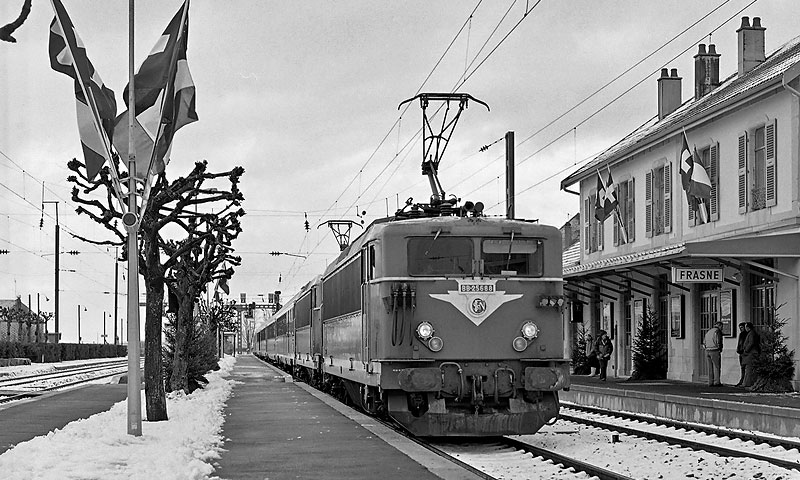 |
| Two pictures of BB 25500 from Dijon depot at Frasne station on the Dijon – Vallorbe line where they had a difficult (20‰ ramps) and diversified duty from the start of their career, including on France to Switzerland international trains. Frasne station is close to Swiss border. Above : a multiple unit with BB 25688 in front, pulling an international train. Station is decorated with flags. Below : a beautiful picture in the snow. BB 25684 is seen pulling train 429 "Jean-Jacques Rousseau", composed of cars in the nice C1 livery. (Photos Jean-Marc Frybourg) |
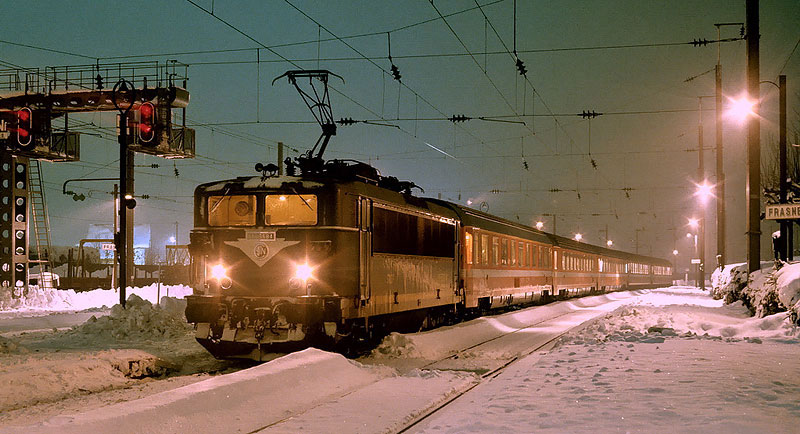
|
Arrival of more powerful BB 25200 in Montrouge depot at the end of 1965, pushed out BB 25500 from the most prestigious trains service. With their double gear ratio (140 / 90 km/h or 87 / 56 MPH), the BB 25500 as versatile locomotives had not seen their use decreased at all. As a matter of fact, following year, the old 2D2 5400 from Montrouge depot were progressively transferred to Bordeaux depot soon followed by the BB 900 also going on South-West region. At the end of 1965, a third depot received some BB 25500 : Marseille-Blancarde. This because of the first step of the Marseille-Toulon-Nice-Vintimille line electrification, along the Mediterranean Sea. Full Marseille-Vintimille line electrification power up took place in 1969. On fast and express heavy trains, the BB 25500 were progressively replaced by the BB 25220 to 25246, able to run at 160 km/h or 100 MPH also delivered at Marseille-Blancarde depot. However, the BB 25500 were still used on a few express trains between Marseille and Nice, and mostly used on numerous freight trains riding on the Côte-d'Azur, mainly at night. They shared the local passenger services with some diesel railcars. As of January 1st 1970, BB25500 were distributed as follows : • Montrouge : 22 locomotives Meanwhile, the Chalindrey-Dijon line electrification occurred but did not bring any additional duty to the Dijon depot locomotives. As a matter of fact, on this line supporting a heavy freight traffic linking Lorraine region to South East, the BB 25100 of Chalindrey depot were having a near-monopoly. On the Paris-Dijon-Vallorbe line, delivery of the first two CC 21000 took away the most prestigious trains from the BB 25500. Delivery of BB 25501 to 25694 were meanwhile carried on. As of January 1st 1973, BB 25500 were distributed as follows : In preparation of electrification of the “Grande Ceinture” (circular line around Paris area), a new depot received some BB 25500 : Les Aubrais. This depot already had a hundred of BB 8500, a series of locomotives for 1500V DC only, directly based on the BB 25500 type. Eventually, the 194 BB 25500, were all delivered in January 1976. Montrouge, Dijon and Marseille depots had even more locomotives and Les Aubrais one reached a number of 50. Electric traction interconnections between South West and South East lines electrified with 1500 V DC on one side, and Eastern and Northern lines electrified only in 25 KV 50 Hz AC then became effective. |
|---|
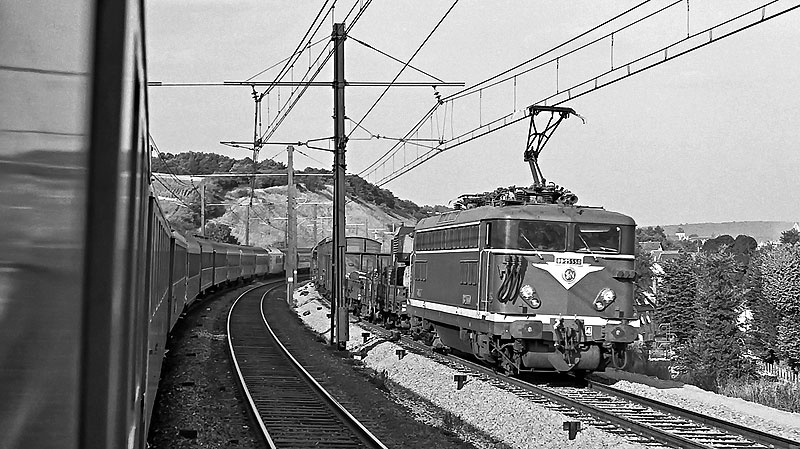 |
Above picture : In 1975, BB 25500 of Les Aubrais depot is seen on the three main tracks section between Etampes and Guillerval. Photo is taken from a train coming across. Corail new passenger cars were to appear on this only a few months laters (Photo Jean-Marc Frybourg) |
BB 22200 deliveries were actively carried on. BB 25500 were more and more concentrated on the inter yards freight traffic going via the “Grande Ceinture”. To ease this intense service and take into account the electrification of west interconnection around Paris, a new depot received some BB 25500 : Achères. In the mid-seventies, the BB 25500 started to be used on suburban services with RIB or RIO reversible stainless steel trains and then on the VO2N and VB2N double deck trains. In the early eighties, electrification of the Tours-Angers and Le Mans-Angers-Nantes lines lead to send some BB 25500 to Tours-St Pierre depot. In 1983, the Le Mans – Nantes line was powered up in AC 25 kV. As a consequence, BB 25500 range increased. To show their operations at that time, we show at the end of this text, an analysis of the Les Aubrais and Achères BB 25500 regular duties on September 30th 1984. In 1985, sections from Lyon to Grenoble and from St André le Gaz to Chambéry were powered up still with AC 25 kV 50 Hz. In an area were, until then 1500 V DC was predominant, use of dual current locomotives imposed itself. BB 25500 of Dijon depot took over this new area, mainly on regional trains. In the second half of the eighties, BB 25500 took over new territories as complementary electrifications in 25 kV AC were occurring, especially in western side of France, reaching St Nazaire, le Croisic, St Brieuc. The BB 22200 fleet only left freight or regional trains to BB 25500 on shorter distances than before. Multiplication of RRR reversible trains acquired by the French regions then gave new interesting services to the BB25500. As a consequence of their services evolutions, adaptations were done in locomotives attributions to different depots :
|
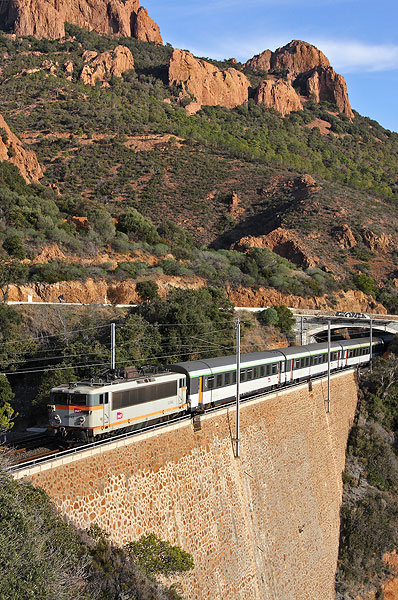 |
In the late eighties, the new BB 26000 appeared. Dual current and versatile, the Sybic (common name given to BB 26000) pushed the BB 25500 towards regional services with reversible RIO or RRR trains. In 1992, Les Aubrais depot lost its last BB 25500. During the nineties, BB 25500 had to face hegemony of BB 22200 and 26000 on the best services requiring dual current locomotives. However, their use remains somewhat stable but on second rank services. In the late nineties, separation of locomotives by activity leaded to deep transformations in the global organization of French Railways. The BB 25500 of Achères and Dijon depot were then attributed to freight activity while the ones from Marseille and Vénissieux were attributed to TER (regional express trains) activity. |
Opposite : At Anthéor on the Côte d'Azur, in the Esterel characteristics red rock hills, a Corail train is seen pulled by a BB 25500 of Marseille depot in the “Concrete” livery with “Carmillon” logo. (Photo Raphaël Emery) |
Freight activity soon decided to stop any heavy maintenance operations on its BB 25500, thus condemning them to withdrawal when reaching service mileage. The brand new BB 27000, dedicated to freight activity also took over most of BB 25500 duties. The BB 25500 were then mainly focused on TER activity. Rennes depot was given some BB 25500 for regional service with reversible trains. A dozen of « small driving cab » BB 25500 were sold to "Régiotrans" operator in Romania. Progressive withdrawal of BB 16500 dedicated to reversible RRR trains pulling leaded to their replacement by some BB 25500, then used only on 25kV 50 Hz AC. It was the case in the Nord-Pas de Calais, in Alsaceand partially in Lorraine regions (for duties to Metz-Rémilly, or Nancy – Epinal orRemiremont). Both Lens and Strasbourg depots then received some BB 25500 for these services. A new hard blow occurred for BB 25500 when Nord-Pas de Calais and PACA regions decided to use modified BB 22200 for RRR regional trains services, thus pushing out the BB 25500 from these services. Along years, various depots using BB 25500 for regional services attributions went down to a now close end for this appreciated series of “Alsthom BB”, after more than 50 years of service !
Text : Pierre Chavernac (january 2017) |
Opposite : A carrer end image. The BB 25606 is seen in Strasbourg station with a regional train to Saverne. On these kind of services, the BB 25500 had replaced withdrawn BB 16500. The BB 25606 had then kept its “Ile de France” (Parisian region) it had received when being used in Montrouge Parisian depot. (Photo Didier Delattre)
|
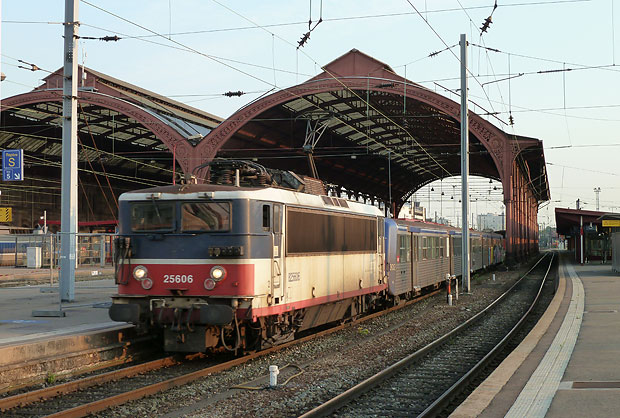 |
Appendix : analysis of regular duty periods in September 1984. On the September 30th 1984 service, Les Aubrais depot used 32 BB 25500. Only three passage trains were included in this service so it was quite anecdotal: • Short distance local train No 8917 between Cambraiand Somain ; On slow freight trains between shunting yards, some nice services could be seen such as St Pierre des Corps to Valenton, Bobigny orVaires, Villeneuve toSomain, Le Havre to Villeneuve, Lille Délivranceto Villeneuve. On bulk-freight trains, somegood services could also be noticed such as Vaires – St Pierre des Corps, St Pierre – Nantes, Valenton – Délivrance, Valenton – Lens, Vierzon – Noisy. Still on the BB 25500 September 1984 service in Les Aubrais, it could be noticed that the accelerated freight traffic was far from negligible in their duties. They had a very intensive service from Creil to Bobigny, Juvisy, Trappes, Lille, Valenton, Corbehem near Douai (brand new automobiles trains). For the same September 30th 1984 service, here is a summary of regular service fir BB 25500 of Achères depot. Service was sprayed on a 49 days period! As for Les Aubrais locomotives, passenger services were much reduced. It wasn’t their vocation and only a few trains were done, to use locomotives during availability periods or positon them better for following services : • Local trains between Lille and Tourcoing, far away from their base ; Achères BB 25500 services looked pretty similar to the Les Aubrais ones, i.e. a majority of interregional freight trains. On the Western side, they were regularly going to Trappes, Le Mans, Rennes, Nantes, Sotteville, le Havre. In the Paris area, as for Les Aubrais locomotives, they were frequently coming on Valenton, Villeneuve, Juvisy, Le Bourget, Vaires, Bobigny, Achères shunting yards. During the same period, BB 25500 of Montrouge depot were used on a 35 days duty period. Drivers from other regions only knew partially these locomotives. Their use was therefore concentrated on the Western region. In the Paris area, they were going to Creil, Achères, Villeneuve, Valenton, Noisy, Juvisy, Tolbiac but were not penetrating Northern region too deeply. On the opposite, their speed ability allowed to use them on more passenger trains, especially on the Montparnasse – Le Mans – Rennes or Nantes, Nantes – Tours, Angers – Le Mans, Rennes – Laval lines. |